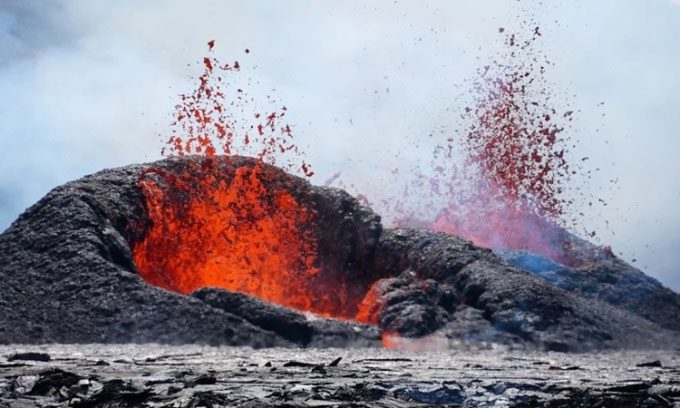Some countries with active volcanoes, such as the United States and Iceland, are harnessing this renewable energy source to generate electricity.
Transforming the bright red lava from active volcanoes into electricity may seem dangerous and unreliable. Volcanoes do not erupt on a predictable schedule, and lava cools too quickly. However, many countries, including the United States, have discovered ways to harness heat from volcanoes to produce electricity. Geothermal energy comes from the heat generated by natural processes deep within the Earth. In most areas, this heat only warms rocks and groundwater near the surface. However, in active volcanic regions, the heat is significantly hotter. Sometimes, it melts rock, forming magma, according to Conversation.

Lava erupting from Kilauea volcano in Hawaii. (Photo: USGS).
Volcanoes act as colossal heat geysers, bringing magma closer to the Earth’s surface. Some of the molten rock may erupt, but much of it remains underground, heating the surrounding rocks and water. Where the heated water rises to the surface, it creates hot springs and geysers that can last for thousands of years. To harness this energy for electricity production, engineers identify areas with magma close to the surface and drill deep wells into the heated rock and water. These wells bring steam to the surface, which is then used to turn turbines in power plants.
After electricity generation, the steam cools and condenses back into hot water, which can be used to vaporize another liquid with a much lower boiling point, such as butane, to run a secondary generator. Eventually, the water is pumped back underground to be reheated.
The Earth continuously generates heat, making geothermal energy a renewable resource. Geothermal power plants produce less pollution, waste, and greenhouse gases that contribute to global warming compared to burning coal, natural gas, oil, or nuclear energy. Geothermal energy sources can last for decades or even longer. Unlike renewable sources such as solar or wind energy, geothermal energy is available 24/7 year-round.
Geothermal energy is being utilized in various locations worldwide, particularly in regions with significant volcanic activity. For instance, nearly all of Iceland’s electricity comes from renewable sources, with geothermal energy providing about 25%. This country is situated on many active volcanoes, making it an ideal location for geothermal power plants. Some states in the United States, such as California and Nevada, also have geothermal power plants located in volcanic regions.
Geothermal energy is not as widely used as solar and wind power because geothermal power plants need to be situated near volcanoes or other areas with unusually hot underground conditions. These resources are not always located near large cities or industrial areas that require substantial electricity. Additionally, drilling deep wells and constructing power plants can be quite expensive. However, the long-term benefits of geothermal energy often outweigh the initial costs. In some cases, drilling and pumping water under high pressure can cause minor earthquakes. Scientists and engineers are working to predict and manage these impacts.


















































